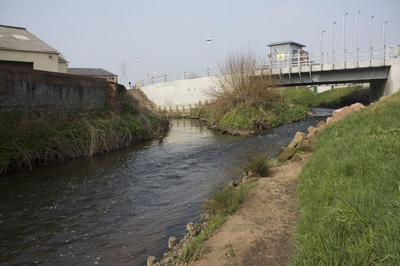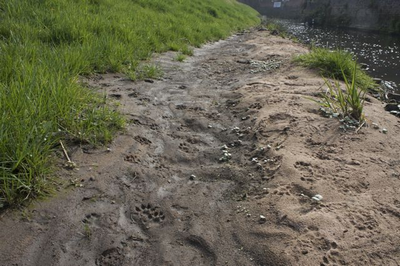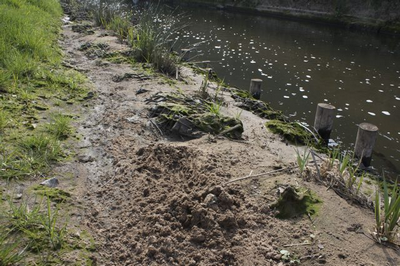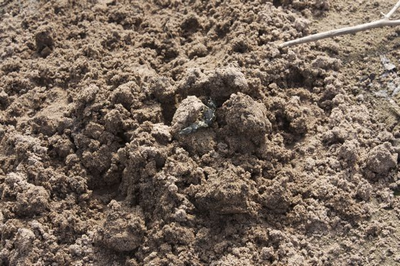During February and March 2009 there has been a long spell of dry weather, and this made conditions ideal for checking watercourses for animal tracks and droppings. Silty banks had been exposed on which tracks could be found, and rocks used as sprainting sites could be checked regularly with no danger of the droppings being washed off by heavy rain between times.
When I examined the exposed sandy ledge below Morrison’s car park (see Photo 1), I could see both obvious otter prints (see Photo 2) plus the characteristic sandy mounds that otters sometimes make to deposit their droppings, called spraints (see Photos 3 and 4). I was very surprised to see evidence of such recent and regular usage of this waterway by otters, and was determined to find out more.
I set out to follow the river and its backwaters through Kidderminster with my binoculars and GPS and I was fascinated with what I found.
As you may know, part of the fast-flowing River Stour was long ago diverted in two places in Kidderminster so that water could be taken through the carpet factories, originally power this industry but also to supply water for cleaning the wool and washing after dyeing. As I was peering over a bridge in the heart of the town I started chatting to an elderly gentleman who asked what I was looking for. He subsequently described what the River Stour used to be like years ago when it ran out through the industrial Black Country and down through the carpet factories in the town. He said that it was so heavily polluted that nothing could live in it and he related how you could tell what colour dyes the carpet factory upstream was using by looking at the river! The water was polluted with chemicals from the dyes, sheep dip and pesticides from the moth proofing process and if you fell into the River Stour, you had to be taken to hospital! He said he was thrilled to see clear water running through Kidderminster again!
I crept through barriers and lurked under bridges in my search for sandy bars and stones with telltale droppings. I found tracks and spraints under the main bridge leading into Tesco’s car park! This was interesting because the whole river was moved across when this area was redeveloped in 2001. There were even otter prints on a small sandy riverside edge behind the shop T. J. Hughes! I then knocked on the door of the Kidderminster Fire Station as I had heard stories of fireman seeing otters when they were on night duty. Although the fireman I spoke to could not elaborate, he kindly took me on a tour of their riverside land and sure enough, I found tracks there too!
Kidderminster is between two important wetland areas – Puxton Marsh to the north and Wilden Marsh south of the town. It is obvious that otters are using the waterways through the town on a regular basis. They are probably using the canals too, but it is harder to find field signs there. Paul Allen, Countryside and Conservation Officer, Wyre Forest District Council, has known about the otters in Kidderminster for some time and has been working with local businesses and schools to ensure that riverbanks are improved for otters to use. Many artificial holts have been put in and trees planted.



